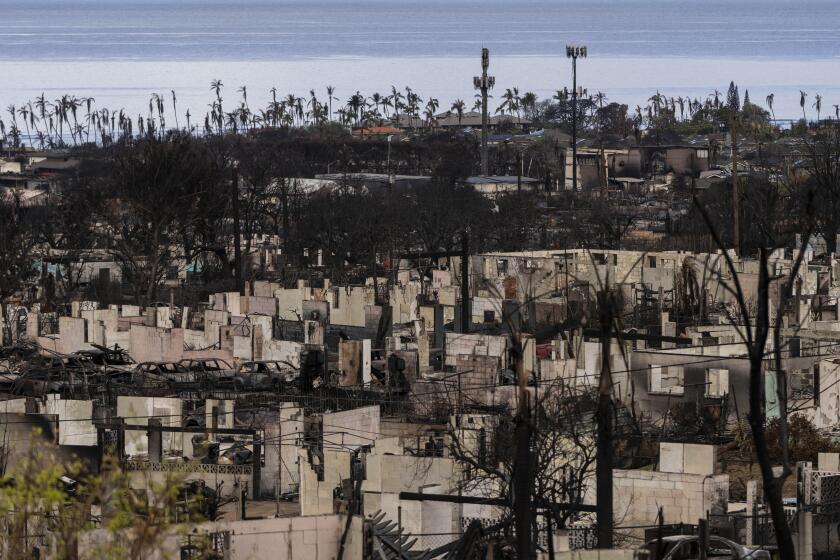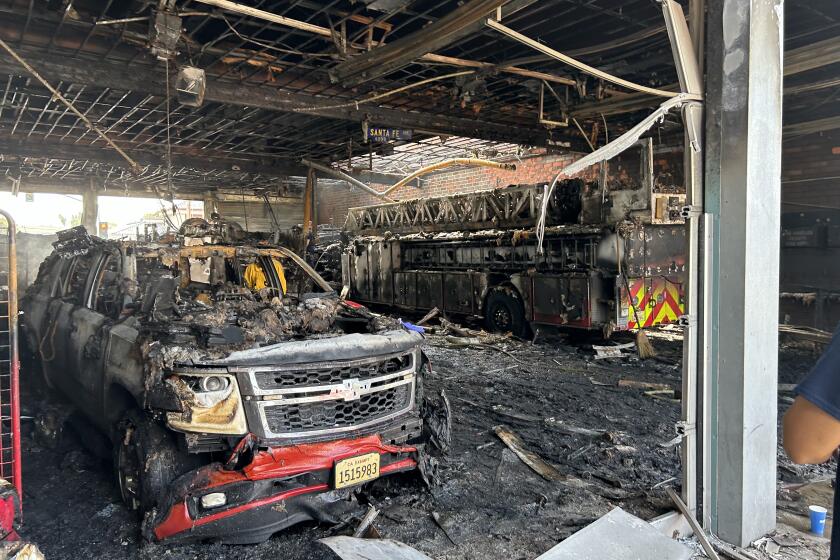Report Traces L.A. Firefighter’s Final 22 Minutes Before Tragedy
Loopholes in city inspection procedures and basic communication errors among firefighters contributed to the death of a Los Angeles City fire captain who was killed inside a burning South-Central factory in March, according to city officials and a report released Wednesday.
The Fire Department’s investigation paints a riveting, tragic picture of the 22 minutes that passed between the entry of firefighters into the flaming Pet Center factory, and the moment when a rescue team discovered Capt. Joseph C. Dupee, dying of burns and smoke inhalation, deep inside the building.
“A lot of things went wrong in combination,” said Fire Department Chief William R. Bamattre. “We have to remember that firefighting is a very dangerous profession.”
Investigators concluded that confusion among firefighters at the scene contributed to a critical delay in the moments after firefighters realized Dupee was trapped inside.
“Members of Dupee’s company tried to inform other captains at the scene that Dupee was missing, but a few crucial minutes passed before a rescue was initiated,” the report says.
But the investigation did not resolve perhaps the most critical question of all: Why did Dupee, a 38-year-old veteran of hundreds of fires, become separated from the other members of Engine Company 57, lost in a burning factory with “near zero visibility”?
“We don’t know exactly what happened,” Bamattre said. “I don’t think we’ll ever know.”
There was little doubt however, about how the fire started. It began as a grease fire in an improperly maintained, incorrectly used oven that prepared flavored “dog chew” toys, according to the report.
Investigators said the factory’s owners had not obtained proper permits for the oven and that the structure, built in 1949, had a conditional use permit to operate as a warehouse, but not as a factory.
Cynthia Mulvihill, an attorney for the company, said she had not been given a copy of the report and could not comment on its findings.
Bureaucratic regulations at the Fire Department and the Department of Building and Safety allowed owners to operate equipment at the factory without the type of thorough inspection that would have detected the dangerous conditions, officials said.
The building was last inspected by Fire Department officials in June 1997. But because the building was less than four stories tall, it was inspected by local firefighters, and not by the more qualified inspectors at the Fire Prevention Bureau, officials said.
The fire that became known in official reports as “Incident 84” probably began hours before neighbors called 911 at 2:20 a.m. Up late at an all-night party, the neighbors had noticed smoke rising from the structure on South Western Avenue.
According to the report, workers at the plant had left the oven on with trays of animal bones cooking inside when they closed up shop.
Firefighters arrived at the scene at 2:22 a.m. After conducting a quick examination, they spent several minutes trying to gain access to the inside, unable to get past the steel front door. As they attacked the door with a rotary saw, the fire spread and gained strength.
Bamattre said the noise of the saw prevented firefighters on the ground from hearing a crucial piece of information transmitted by their colleagues on the roof, who had cut holes in the ceiling and could see the intensity of the flames inside.
Nevertheless, the firefighters on the ground entered the building at 2:30, struggling to see through thick smoke. Six minutes later, the incident commander ordered everyone out.
All but one of the eight men inside made their way out, some crawling along the ground and following their hoses to the front door. Two men became momentarily confused because the hose lines had become tangled into “spaghetti,” the report said.
Dupee was still inside. When the roof near the door collapsed, his colleagues at the door were unable to reach him. A rescue team cut its way through a back door to reach him, but it was too late.
Investigators proposed two theories to explain why Dupee had become separated from his colleagues.
The first suggested that Dupee might have responded to the sound of an alarm made by an emergency device that had been dropped and left behind by a fellow firefighter near the heart of the fire. The alarm usually signals that a fallen colleague needs assistance.
“Anyone who knows Joe knows that’s the kind of officer he is,” said Fire Department spokesman Steve Ruda. “He’s going to go toward that alarm.”
A second theory held that Dupee became disoriented by the smoke and was trapped by the roof collapse.
Investigators said that Dupee fell just a few feet from the oven. He had opened the oven’s door, apparently mistaking it for an escape route. It was a fateful error. Opening the oven created a “back draft,” an explosion of fire that probably knocked Dupee unconscious, unable to activate his own emergency communications devices.
The report suggests that other human factors may have contributed to the accident, including fatigue and lack of unit cohesion. Dupee was working the second of two consecutive 24-hour shifts, and at least two firefighters at the scene were inspectors who had been recently transferred to emergency duty because of budget cuts.
Though the report says improper use of the oven started the fire, the district attorney’s office has decided against prosecuting the owners, fire department officials said.
Bamattre said investigators had found “improper use, but not criminal negligence.”
David R. Keim, principal building inspector for the city Department of Building and Safety, said his department had not visited the site of the fire for several years prior to the blaze.
The Building and Safety Department does not conduct routine inspections of such facilities.
More to Read
Start your day right
Sign up for Essential California for news, features and recommendations from the L.A. Times and beyond in your inbox six days a week.
You may occasionally receive promotional content from the Los Angeles Times.







